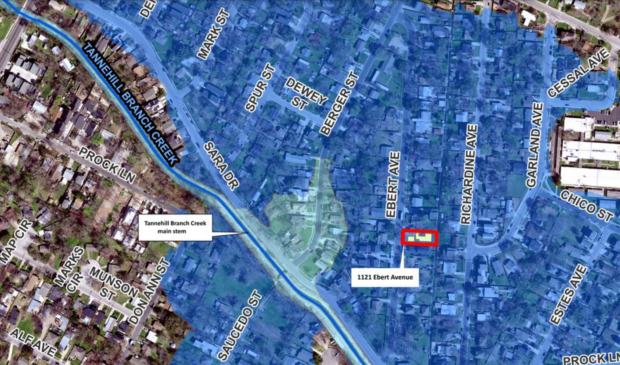Council OKs variance to build home in the floodplain
Monday, January 22, 2024 by
Jo Clifton After hearing from the city’s floodplain administrator and the owner of an east side property, City Council unanimously approved two variances to the city’s floodplain regulations on Thursday. Their action will allow property owner Luc Pham to build a house in the 100-year floodplain of Tannehill Branch Creek. The proposed home will be at 1121 Ebert Ave. in an area southeast of Springdale Road.
Kevin Shunk, the city’s floodplain administrator, told Council the whole neighborhood is within the 100-year floodplain. He explained that a house was built on the property in 1963, but that house burned down years later and has not been replaced.
Pham proposes to build a 2,400-square-foot house plus a detached garage. Both will be built using pier and beams so floodwaters can flow through. Shunk recommended that Council approve the variance, explaining that the development would not cause any adverse impact on other properties, particularly additional flooding.
The new house is proposed to have a finished floor elevation of 2.2 feet above the 100-year floodplain. City regulations require a minimum of 2 feet above the floodplain elevation. Shunk told Council the city’s floodplain regulations are stricter than those of the Federal Emergency Management Agency. For example, federal regulations do not require that a building be built higher than the floodplain.
Shunk explained that the major problem facing the homeowner – and the reason for the variance request – is that the proposed development’s access point to the right of way is located within the 100-year floodplain. The depth of water during a 100-year flood on Ebert Avenue is expected to be 1 foot. That means first responders and people living in the house will not have safe access to and from the house during a 100-year flood event. The location of the floodplain is a characteristic of the land itself, according to documents related to the variance.
The ordinance Council approved states that Council finds “variances granted by this ordinance are the minimum necessary to afford relief and are based on good and sufficient cause, and that failure to grant the variances would result in exceptional hardship. Council further finds that the variances granted in this ordinance will not result in increased flood heights, additional threats to public safety, extraordinary public expense, create a nuisance, cause fraud on or victimization of the public, or conflict with existing local laws or ordinances.”
Council Member Paige Ellis told Pham she would support the variance but that she wanted to offer him “a couple of words of wisdom.” Another person built a home in the same neighborhood a few years ago, she said, “but they didn’t build the substrate correctly,” referring to materials supporting the foundation. As a result, she said, that person was unable to get a certificate of occupancy. After the vote, Shunk also told Pham to take the warning seriously.
The Austin Monitor’s work is made possible by donations from the community. Though our reporting covers donors from time to time, we are careful to keep business and editorial efforts separate while maintaining transparency. A complete list of donors is available here, and our code of ethics is explained here.
You're a community leader
And we’re honored you look to us for serious, in-depth news. You know a strong community needs local and dedicated watchdog reporting. We’re here for you and that won’t change. Now will you take the powerful next step and support our nonprofit news organization?






